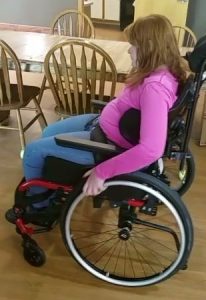
Dynamic Seating has improved Amanda’s ability to self-propel her manual wheelchair.
Michelle L. Lange, OTR/L, ABDA, ATP/SMS
Our last blog answered the question, Can Dynamic Seating Improve Postural Control?. Research has demonstrated improvements in postural control, particularly in trunk and head control, with the use of Dynamic Seating. Research has further demonstrated that a Dynamic Seating intervention can improve function. Let’s take a look!
Improved functioning has been found in people using dynamic seating (Adlam, et al., 2015; Adlam, et al., 2014; Crane, et al., 2007; Incoronato, 2006). A number of studies found a specific improvement in control of the upper extremities (Dalton, 2014; Cimolin, et al., 2009; Incoronato, 2007; Incoronato, 2006). One study showed an improvement in the use of assistive technology (Adlam, et al., 2015). In my own experience and in reports from other clinicians, suppliers, and clients – many have found an improvement in the use of assistive technology. As an example, Robert was able to use his communication device better.
A number of other functional changes have been documented. Dynamic seating has been found to reduce energy consumption (Ferrari, 2003) and increase range of motion and movement (Adlam, et al., 2014; Avellis, et al., 2010; Hahn, et al., 2009; Incoronato, 2007). Medically, dynamic seating improves digestion (Incoronato, 2007), breathing (Crane, et al., 2007; Ferrari, 2003), vocalization (Adlam, et al., 2014), and visual field. (Ferrari, 2003). Finally, Adlam, et al. (2015) found increased social engagement with dynamic seating intervention.
So, what’s the bottom line? Dynamic Seating can improve function, including medical functioning. Now that is a clinical benefit I can get on board with!
References:
** This post was originally published on https://www.seatingdynamics.com/2020/06/02/can-dynamic-seating-improve-function/

